check engine SKODA FABIA 2000 1.G / 6Y User Guide
[x] Cancel search | Manufacturer: SKODA, Model Year: 2000, Model line: FABIA, Model: SKODA FABIA 2000 1.G / 6YPages: 86, PDF Size: 3.58 MB
Page 27 of 86
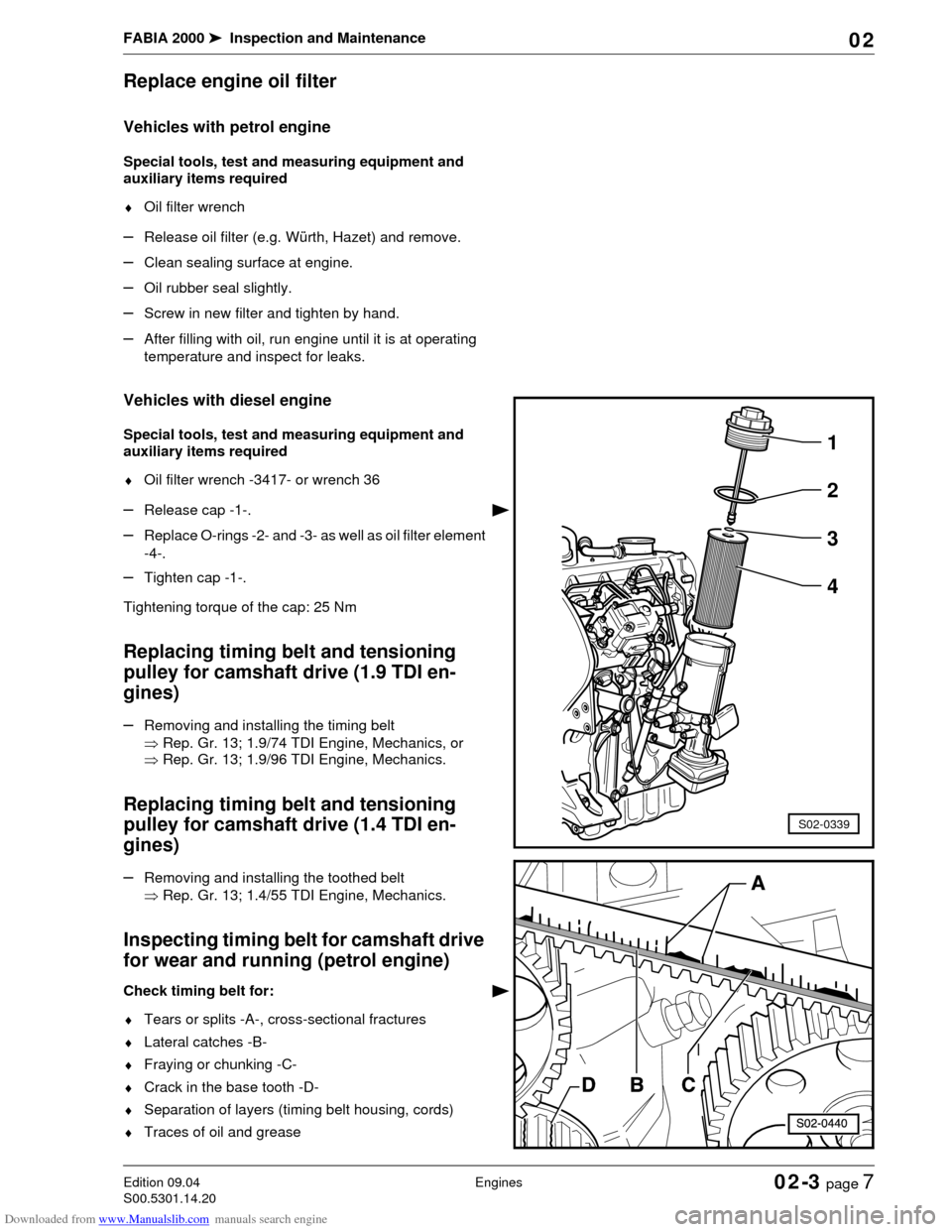
Downloaded from www.Manualslib.com manuals search engine FABIA 2000➤Inspection and Maintenance
EnginesEdition 09.04
S00.5301.14.2002-3 page 7 02
Replace engine oil filter
Vehicles with petrol engine
Special tools, test and measuring equipment and
auxiliary items required
♦Oil filter wrench
–Release oil filter (e.g. Würth, Hazet) and remove.
–Clean sealing surface at engine.
–Oil rubber seal slightly.
–Screw in new filter and tighten by hand.
–After filling with oil, run engine until it is at operating
temperature and inspect for leaks.
Vehicles with diesel engine
Special tools, test and measuring equipment and
auxiliary items required
♦Oil filter wrench -3417- or wrench 36
–Release cap -1-.
–Replace O-rings -2- and -3- as well as oil filter element
-4-.
–Tighten cap -1-.
Tightening torque of the cap: 25 Nm
Replacing timing belt and tensioning
pulley for camshaft drive (1.9 TDI en-
gines)
–Removing and installing the timing belt
⇒Rep. Gr. 13; 1.9/74 TDI Engine, Mechanics, or
⇒Rep. Gr. 13; 1.9/96 TDI Engine, Mechanics.
Replacing timing belt and tensioning
pulley for camshaft drive (1.4 TDI en-
gines)
–Removing and installing the toothed belt
⇒Rep. Gr. 13; 1.4/55 TDI Engine, Mechanics.
Inspecting timing belt for camshaft drive
for wear and running (petrol engine)
Check timing belt for:
♦Tears or splits -A-, cross-sectional fractures
♦Lateral catches -B-
♦Fraying or chunking -C-
♦Crack in the base tooth -D-
♦Separation of layers (timing belt housing, cords)
♦Traces of oil and grease
S02-0339
2
1
4
3
Page 30 of 86
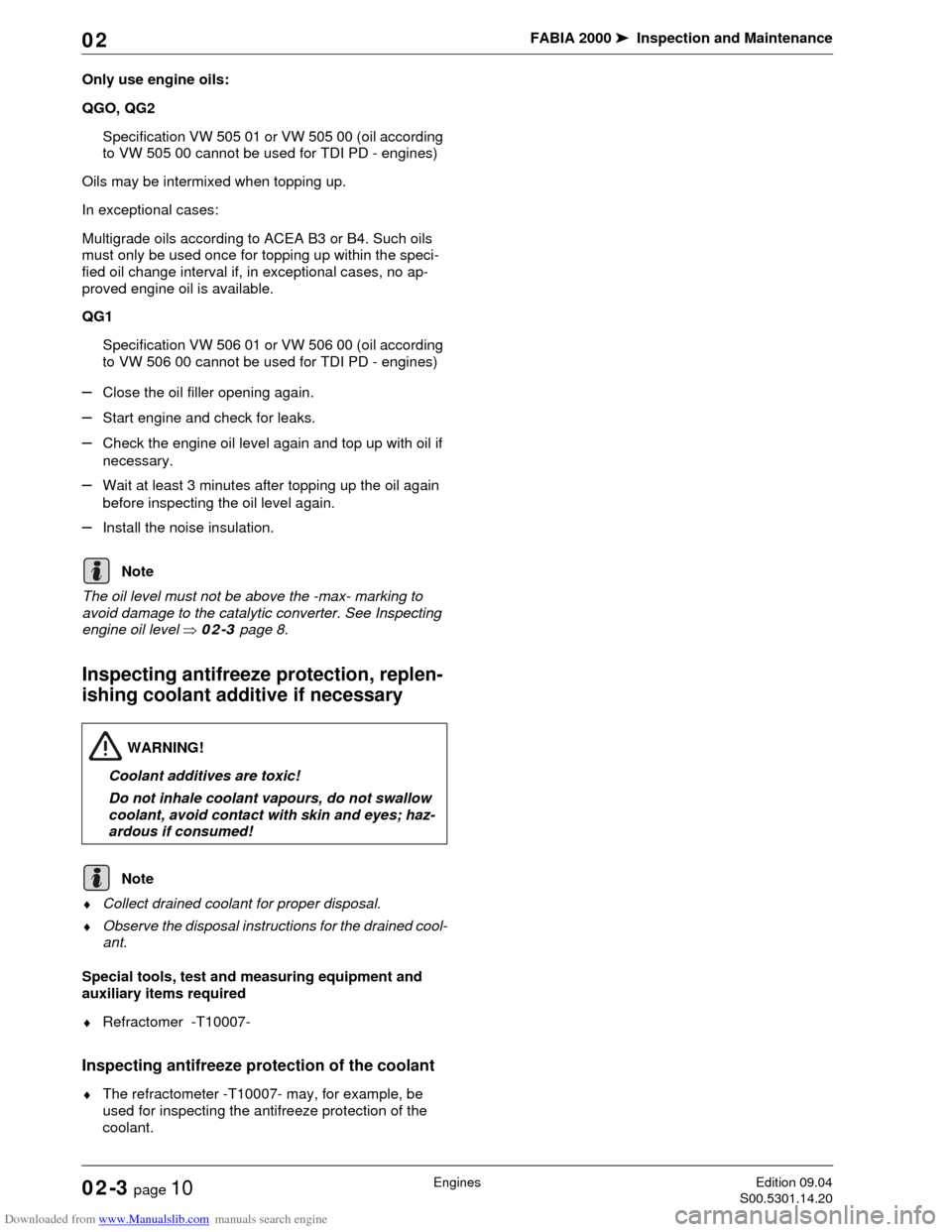
Downloaded from www.Manualslib.com manuals search engine FABIA 2000➤Inspection and Maintenance
EnginesEdition 09.04
S00.5301.14.2002-3 page 10 02
Only use engine oils:
QGO, QG2
Specification VW 505 01 or VW 505 00 (oil according
to VW 505 00 cannot be used for TDI PD - engines)
Oils may be intermixed when topping up.
In exceptional cases:
Multigrade oils according to ACEA B3 or B4. Such oils
must only be used once for topping up within the speci-
fied oil change interval if, in exceptional cases, no ap-
proved engine oil is available.
QG1
Specification VW 506 01 or VW 506 00 (oil according
to VW 506 00 cannot be used for TDI PD - engines)
–Close the oil filler opening again.
–Start engine and check for leaks.
–Check the engine oil level again and top up with oil if
necessary.
–Wait at least 3 minutes after topping up the oil again
before inspecting the oil level again.
–Install the noise insulation.
The oil level must not be above the -max- marking to
avoid damage to the catalytic converter. See Inspecting
engine oil level ⇒02-3 page 8.
Inspecting antifreeze protection, replen-
ishing coolant additive if necessary
♦Collect drained coolant for proper disposal.
♦Observe the disposal instructions for the drained cool-
ant.
Special tools, test and measuring equipment and
auxiliary items required
♦Refractomer -T10007-
Inspecting antifreeze protection of the coolant
♦The refractometer -T10007- may, for example, be
used for inspecting the antifreeze protection of the
coolant.
Note
WARNING!
Coolant additives are toxic!
Do not inhale coolant vapours, do not swallow
coolant, avoid contact with skin and eyes; haz-
ardous if consumed!
Note
Page 32 of 86
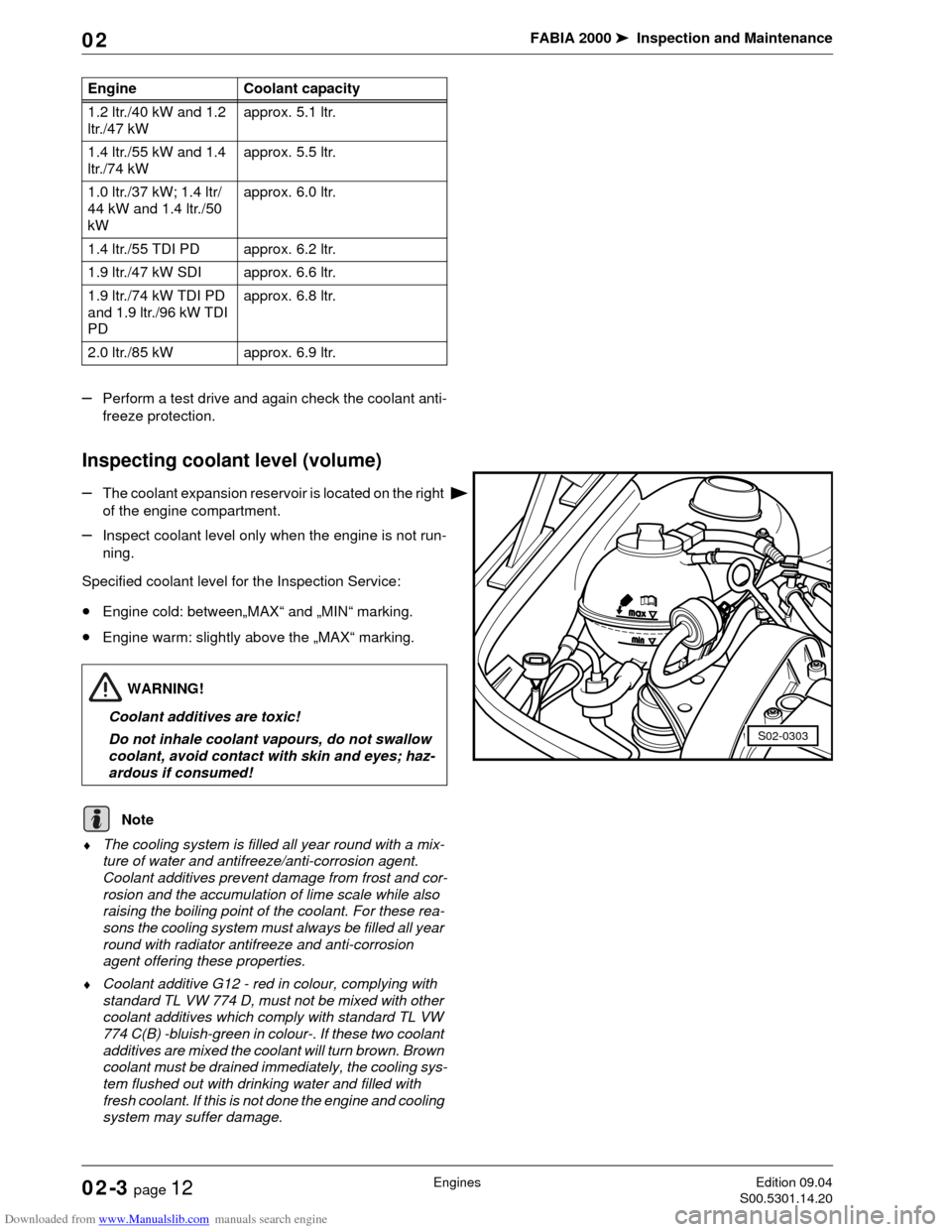
Downloaded from www.Manualslib.com manuals search engine FABIA 2000➤Inspection and Maintenance
EnginesEdition 09.04
S00.5301.14.2002-3 page 12 02
–Perform a test drive and again check the coolant anti-
freeze protection.
Inspecting coolant level (volume)
–The coolant expansion reservoir is located on the right
of the engine compartment.
–Inspect coolant level only when the engine is not run-
ning.
Specified coolant level for the Inspection Service:
•Engine cold: between„MAX“ and „MIN“ marking.
•Engine warm: slightly above the „MAX“ marking.
♦The cooling system is filled all year round with a mix-
ture of water and antifreeze/anti-corrosion agent.
Coolant additives prevent damage from frost and cor-
rosion and the accumulation of lime scale while also
raising the boiling point of the coolant. For these rea-
sons the cooling system must always be filled all year
round with radiator antifreeze and anti-corrosion
agent offering these properties.
♦Coolant additive G12 - red in colour, complying with
standard TL VW 774 D, must not be mixed with other
coolant additives which comply with standard TL VW
774 C(B) -bluish-green in colour-. If these two coolant
additives are mixed the coolant will turn brown. Brown
coolant must be drained immediately, the cooling sys-
tem flushed out with drinking water and filled with
fresh coolant. If this is not done the engine and cooling
system may suffer damage. Engine Coolant capacity
1.2 ltr./40 kW and 1.2
ltr./47 kWapprox. 5.1 ltr.
1.4 ltr./55 kW and 1.4
ltr./74 kWapprox. 5.5 ltr.
1.0 ltr./37 kW; 1.4 ltr/
44 kW and 1.4 ltr./50
kWapprox. 6.0 ltr.
1.4 ltr./55 TDI PD approx. 6.2 ltr.
1.9 ltr./47 kW SDI approx. 6.6 ltr.
1.9 ltr./74 kW TDI PD
and 1.9 ltr./96 kW TDI
PDapprox. 6.8 ltr.
2.0 ltr./85 kW approx. 6.9 ltr.
S02-0303
WARNING!
Coolant additives are toxic!
Do not inhale coolant vapours, do not swallow
coolant, avoid contact with skin and eyes; haz-
ardous if consumed!
Note
Page 34 of 86
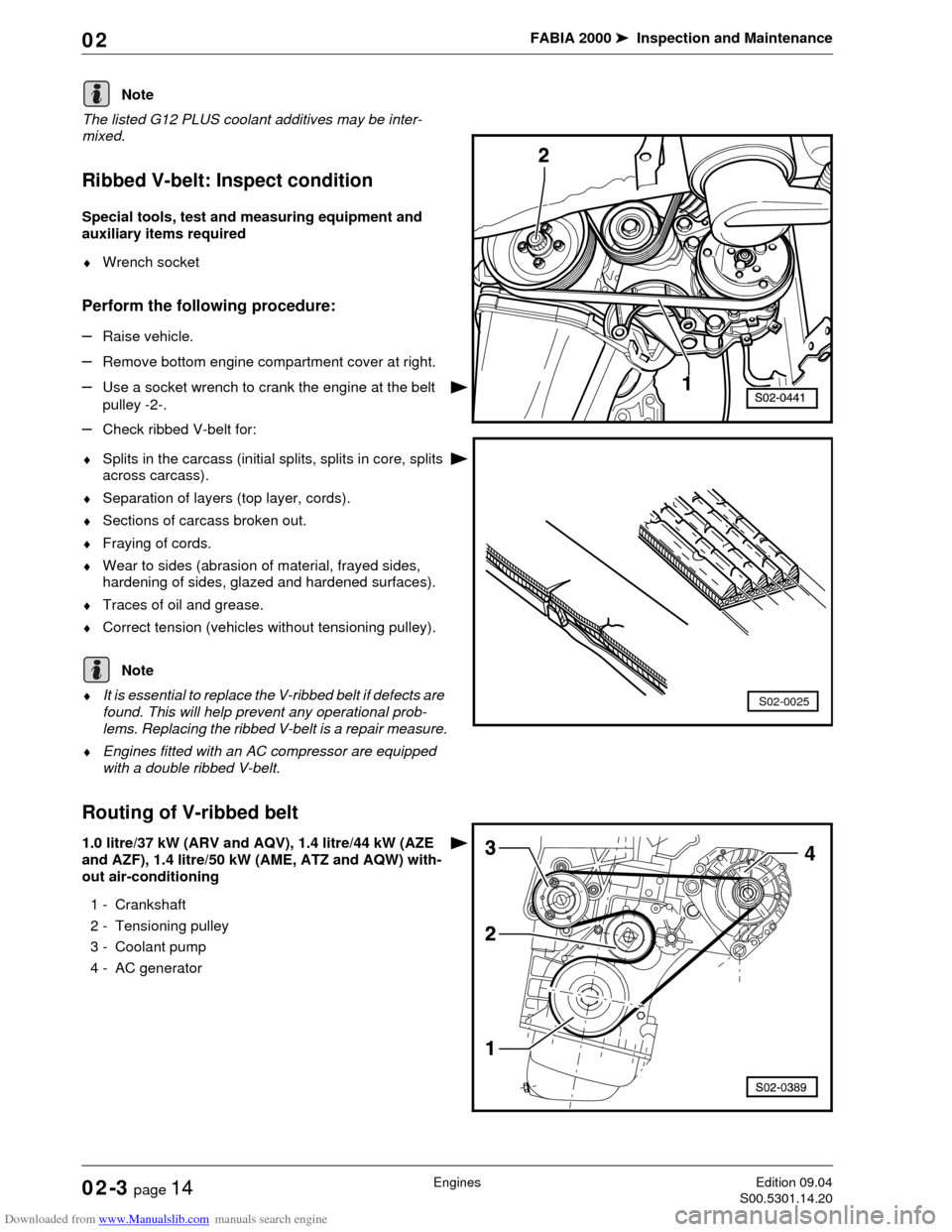
Downloaded from www.Manualslib.com manuals search engine FABIA 2000➤Inspection and Maintenance
EnginesEdition 09.04
S00.5301.14.2002-3 page 14 02
The listed G12 PLUS coolant additives may be inter-
mixed.
Ribbed V-belt: Inspect condition
Special tools, test and measuring equipment and
auxiliary items required
♦Wrench socket
Perform the following procedure:
–Raise vehicle.
–Remove bottom engine compartment cover at right.
–Use a socket wrench to crank the engine at the belt
pulley -2-.
–Check ribbed V-belt for:
♦Splits in the carcass (initial splits, splits in core, splits
across carcass).
♦Separation of layers (top layer, cords).
♦Sections of carcass broken out.
♦Fraying of cords.
♦Wear to sides (abrasion of material, frayed sides,
hardening of sides, glazed and hardened surfaces).
♦Traces of oil and grease.
♦Correct tension (vehicles without tensioning pulley).
♦It is essential to replace the V-ribbed belt if defects are
found. This will help prevent any operational prob-
lems. Replacing the ribbed V-belt is a repair measure.
♦Engines fitted with an AC compressor are equipped
with a double ribbed V-belt.
Routing of V-ribbed belt
1.0 litre/37 kW (ARV and AQV), 1.4 litre/44 kW (AZE
and AZF), 1.4 litre/50 kW (AME, ATZ and AQW) with-
out air-conditioning
1 - Crankshaft
2 - Tensioning pulley
3 - Coolant pump
4 - AC generator
Note
S02-0025
Note
Page 38 of 86
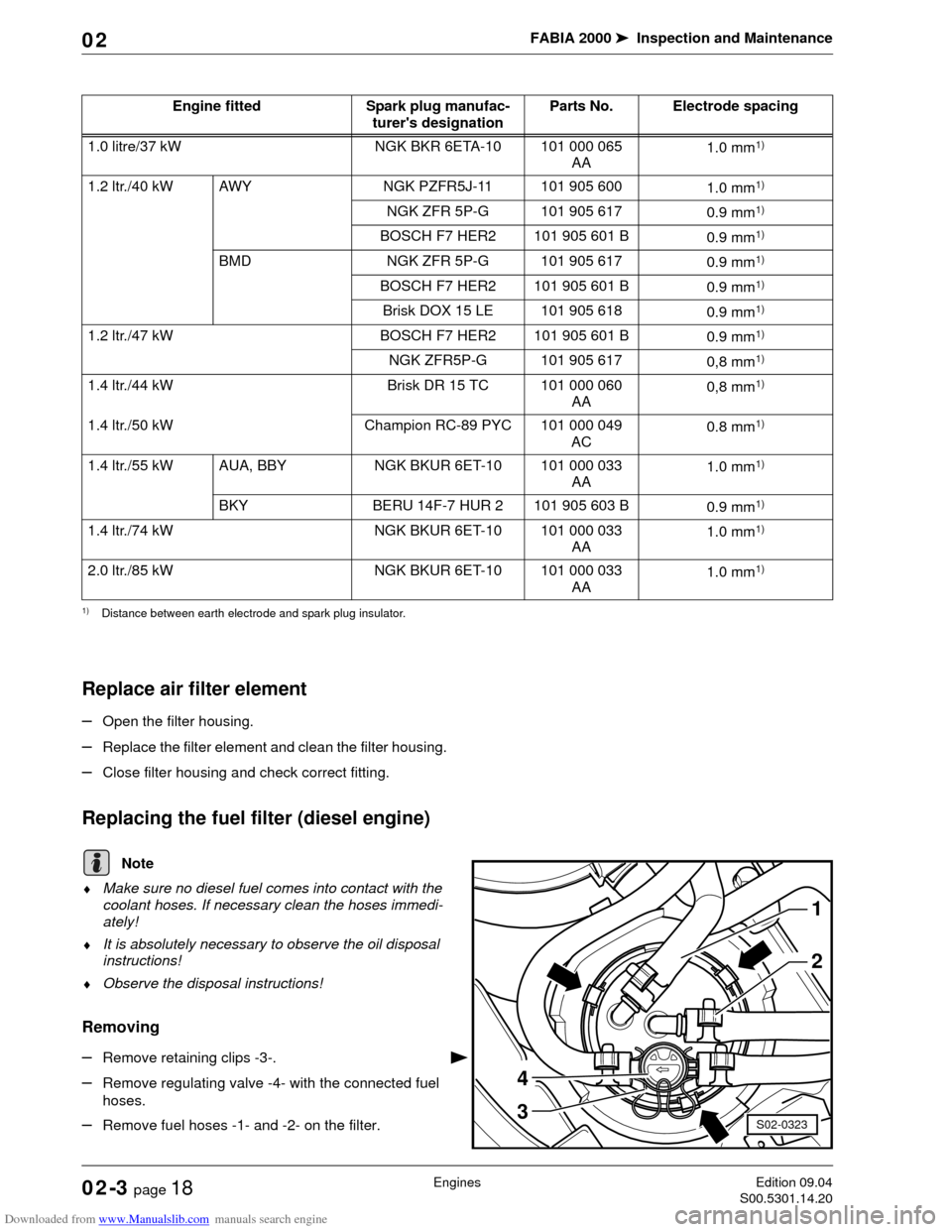
Downloaded from www.Manualslib.com manuals search engine FABIA 2000➤Inspection and Maintenance
EnginesEdition 09.04
S00.5301.14.2002-3 page 18 02
Replace air filter element
–Open the filter housing.
–Replace the filter element and clean the filter housing.
–Close filter housing and check correct fitting.
Replacing the fuel filter (diesel engine)
♦Make sure no diesel fuel comes into contact with the
coolant hoses. If necessary clean the hoses immedi-
ately!
♦It is absolutely necessary to observe the oil disposal
instructions!
♦Observe the disposal instructions!
Removing
–Remove retaining clips -3-.
–Remove regulating valve -4- with the connected fuel
hoses.
–Remove fuel hoses -1- and -2- on the filter.Engine fitted Spark plug manufac-
turer's designationParts No. Electrode spacing
1.0 litre/37 kW NGK BKR 6ETA-10 101 000 065
AA1.0 mm
1)
1) Distance between earth electrode and spark plug insulator.
1.2 ltr./40 kW AWY NGK PZFR5J-11 101 905 600
1.0 mm1)
NGK ZFR 5P-G 101 905 617
0.9 mm1)
BOSCH F7 HER2 101 905 601 B
0.9 mm1)
BMD NGK ZFR 5P-G 101 905 617
0.9 mm1)
BOSCH F7 HER2 101 905 601 B
0.9 mm1)
Brisk DOX 15 LE 101 905 618
0.9 mm1)
1.2 ltr./47 kW BOSCH F7 HER2 101 905 601 B
0.9 mm1)
NGK ZFR5P-G 101 905 617
0,8 mm1)
1.4 ltr./44 kW Brisk DR 15 TC 101 000 060
AA0,8 mm1)
1.4 ltr./50 kW Champion RC-89 PYC 101 000 049
AC0.8 mm1)
1.4 ltr./55 kW AUA, BBY NGK BKUR 6ET-10 101 000 033
AA1.0 mm1)
BKY BERU 14F-7 HUR 2 101 905 603 B
0.9 mm1)
1.4 ltr./74 kW NGK BKUR 6ET-10 101 000 033
AA1.0 mm1)
2.0 ltr./85 kW NGK BKUR 6ET-10 101 000 033
AA1.0 mm1)
Note
1
2
3
4
S02-0323
Page 41 of 86

Downloaded from www.Manualslib.com manuals search engine FABIA 2000➤Inspection and Maintenance
GearboxEdition 07.03
S00.5301.12.2002-4 page 1 02
02-4 Gearbox
Gearbox/Final drive: Check the oil level
and top it if necessary
5 speed gearbox 002
Gearbox oil specification: G50 SAE 75W90 (synthetic oil)
–Unscrew plug for inspecting gear oil -arrow-.
The oil is at the correct level if the gear is filled up to the
lower edge of the oil filler hole.
–Tighten plug -arrow-, 25 Nm.
When topping up, pay attention to the following
points:
–Unscrew plug for inspecting gear oil -arrow-.
–Pour in gear oil up to lower edge of the filler hole.
–Screw in plug -arrow-.
–Start engine, engage a gear and allow gearbox to ro-
tate for about 2 minutes.
–Switch off engine, unscrew plug -arrow- and top up
gear oil to lower edge of the filler hole.
–Tighten plug -arrow-, 25 Nm.
5 speed gearbox 02R
Gearbox oil specification: G50 SAE 75W90 (synthetic oil)
–Remove noise insulation panel -arrows-.
–Unscrew plug for inspecting gear oil -arrow-.
The oil is at the correct level if the gear is filled up to the
lower edge of the oil filler hole.
–Tighten plug -arrow-, 30 Nm.
When topping up, pay attention to the following
points:
–Unscrew plug for inspecting gear oil -arrow-.
–Pour in gear oil up to lower edge of the filler hole.
–Screw in plug -arrow-.
–Start engine, engage a gear and allow gearbox to ro-
tate for about 2 minutes.
–Switch off engine, unscrew plug -arrow- and top up
gear oil to lower edge of the filler hole.
–Tighten plug -arrow-, 30 Nm.
5 speed gearbox 02T
Special tools, test and measuring equipment and
auxiliary items required
♦Socket wrench insert -T30023 (3357)-
S34-0408
S10-0101
S34-0498
Page 51 of 86
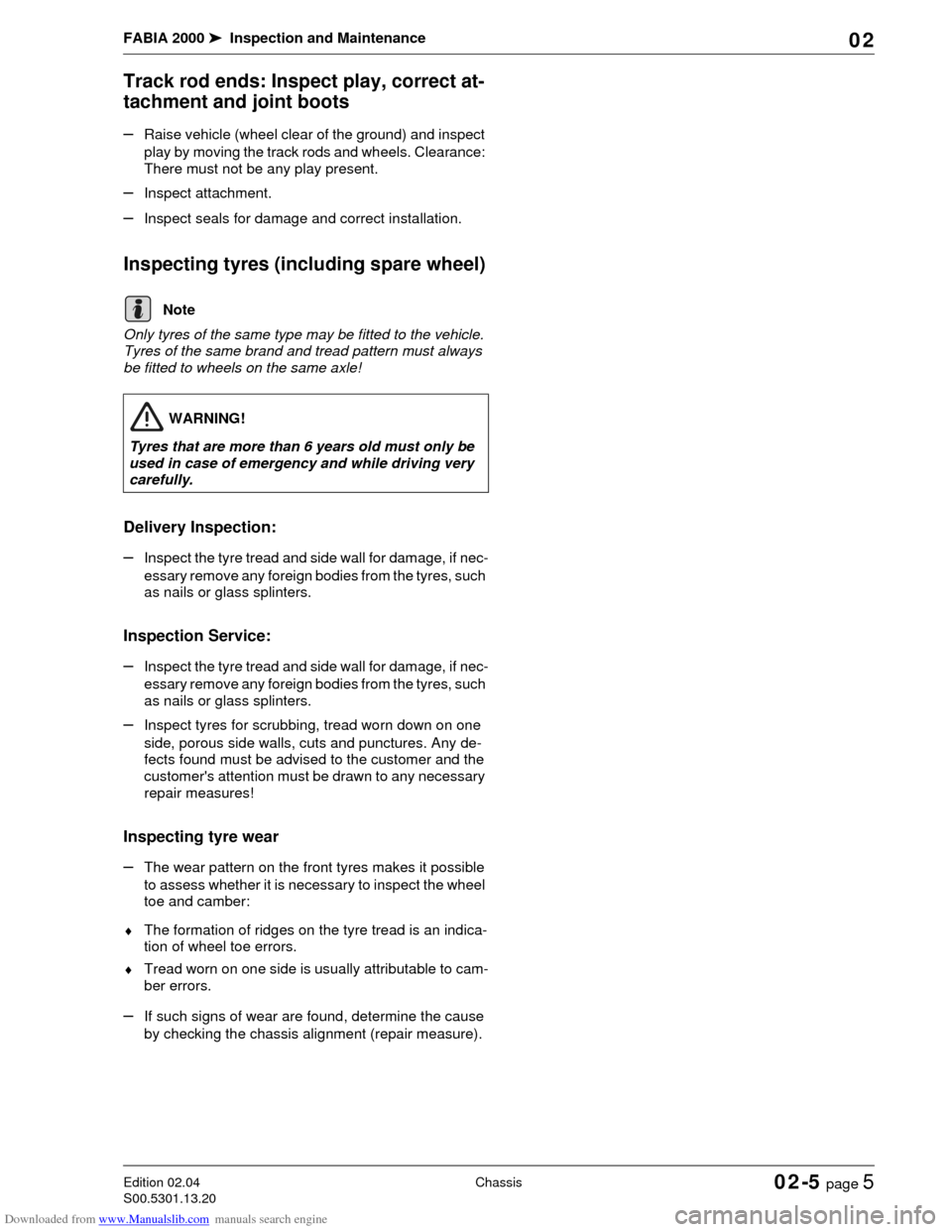
Downloaded from www.Manualslib.com manuals search engine FABIA 2000➤Inspection and Maintenance
ChassisEdition 02.04
S00.5301.13.2002-5 page 5 02
Track rod ends: Inspect play, correct at-
tachment and joint boots
–Raise vehicle (wheel clear of the ground) and inspect
play by moving the track rods and wheels. Clearance:
There must not be any play present.
–Inspect attachment.
–Inspect seals for damage and correct installation.
Inspecting tyres (including spare wheel)
Only tyres of the same type may be fitted to the vehicle.
Tyres of the same brand and tread pattern must always
be fitted to wheels on the same axle!
Delivery Inspection:
–Inspect the tyre tread and side wall for damage, if nec-
essary remove any foreign bodies from the tyres, such
as nails or glass splinters.
Inspection Service:
–Inspect the tyre tread and side wall for damage, if nec-
essary remove any foreign bodies from the tyres, such
as nails or glass splinters.
–Inspect tyres for scrubbing, tread worn down on one
side, porous side walls, cuts and punctures. Any de-
fects found must be advised to the customer and the
customer's attention must be drawn to any necessary
repair measures!
Inspecting tyre wear
–The wear pattern on the front tyres makes it possible
to assess whether it is necessary to inspect the wheel
toe and camber:
♦The formation of ridges on the tyre tread is an indica-
tion of wheel toe errors.
♦Tread worn on one side is usually attributable to cam-
ber errors.
–If such signs of wear are found, determine the cause
by checking the chassis alignment (repair measure).
Note
WARNING!
Tyres that are more than 6 years old must only be
used in case of emergency and while driving very
carefully.
Page 55 of 86

Downloaded from www.Manualslib.com manuals search engine FABIA 2000➤Inspection and Maintenance
Electrical SystemEdition 09.04
S00.5301.14.2002-6 page 1 02
02-6 Electrical System
Power windows: Inspecting positioning
If the battery is diconnected the power windows forget
their current position.
Test conditions:
•All car doors closed
The inspection procedure is carried out from the outside
Close window with the car key using the convenience
closing system.
–Turn car key into close position and hold until all the
windows are closed.
–After closing the windows hold the key in the close po-
sition for approximately another 3 seconds.
Electrical components: Check for proper
operation
–Inspect lighting, main headlights, headlight beam con-
trol, fog lights, turn signal lights, hazard warning light
system, tail lights, rear fog lights, reversing lights,
brake lights, parking light control for brightness and
proper operation.
–Inspect interior lights, illuminated storage compart-
ment, illuminated ashtray for proper operation.
–Airbag warning lamps: Check operation ⇒Chapter
02-7.
–Inspect warning buzzer, onboard computer, all switch-
es in centre console as well as on the dash panel and
horn for proper operation.
–Inspect power windows, exterior mirrors (heated and
electrically adjustable), central locking system, infra-
red remote control and convenience closing system
for proper operation
–Inspect heating of front seats for proper operation.
–Inspect radio for proper reception and absence of in-
terference, also inspect speakers ⇒02-6 page 2.
Battery: Testing no-load voltage
Special tools, test and measuring equipment and
auxiliary items required
♦Multimeter (e.g. -V.A.G 1526 A-)
Prior to the measurement the vehicle must have been in
the no-load state for at least two hours (no engine starts,
no charging or discharging of battery).
The following procedure applies to measuring the battery
voltage in the no-load state (after at least two hours):
–With the battery installed measure the voltage be-
tween the terminals (ignition switched off).
Page 56 of 86
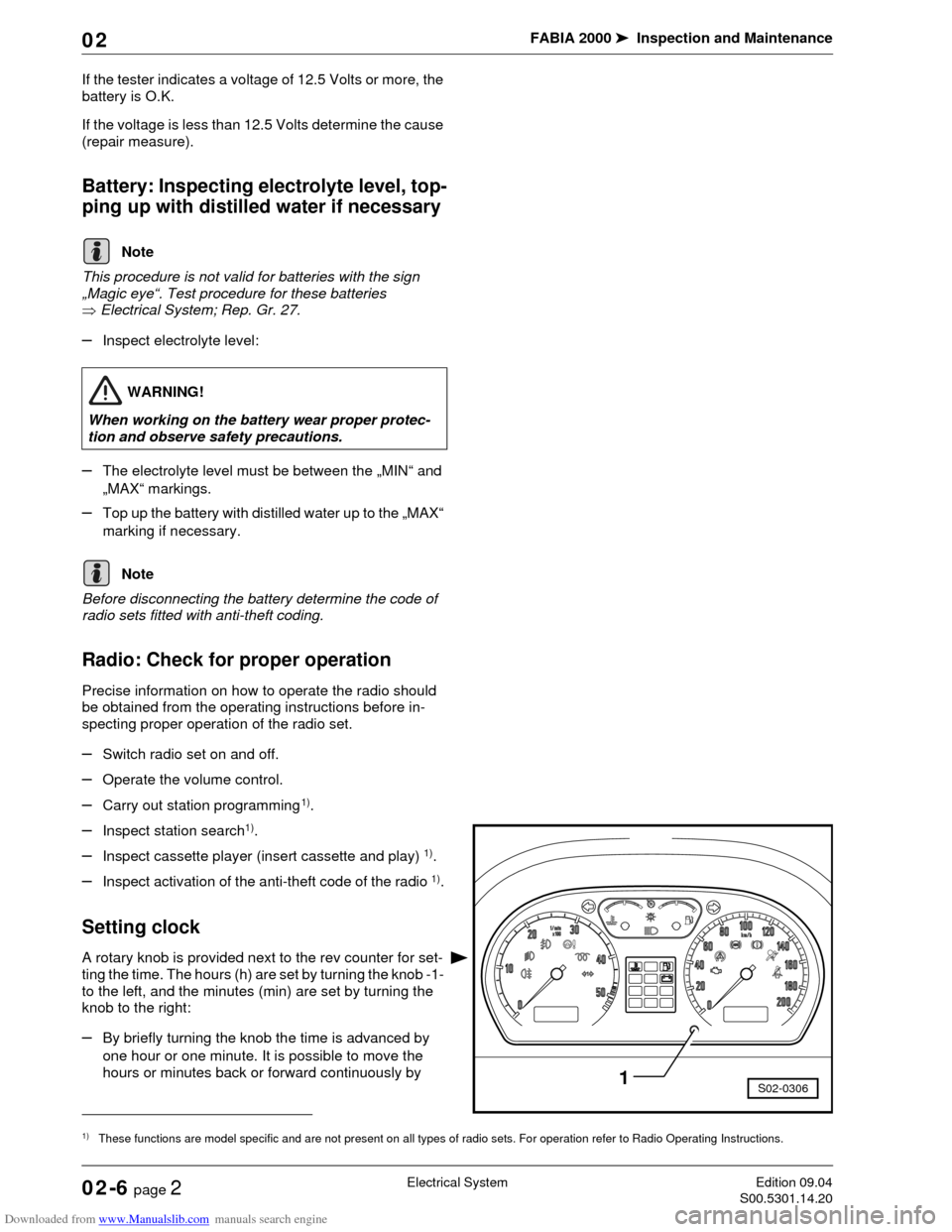
Downloaded from www.Manualslib.com manuals search engine FABIA 2000➤Inspection and Maintenance
Electrical SystemEdition 09.04
S00.5301.14.2002-6 page 2 02
If the tester indicates a voltage of 12.5 Volts or more, the
battery is O.K.
If the voltage is less than 12.5 Volts determine the cause
(repair measure).
Battery: Inspecting electrolyte level, top-
ping up with distilled water if necessary
This procedure is not valid for batteries with the sign
„Magic eye“. Test procedure for these batteries
⇒Electrical System; Rep. Gr. 27.
–Inspect electrolyte level:
–The electrolyte level must be between the „MIN“ and
„MAX“ markings.
–Top up the battery with distilled water up to the „MAX“
marking if necessary.
Before disconnecting the battery determine the code of
radio sets fitted with anti-theft coding.
Radio: Check for proper operation
Precise information on how to operate the radio should
be obtained from the operating instructions before in-
specting proper operation of the radio set.
–Switch radio set on and off.
–Operate the volume control.
–Carry out station programming1).
–Inspect station search1).
–Inspect cassette player (insert cassette and play) 1).
–Inspect activation of the anti-theft code of the radio 1).
Setting clock
A rotary knob is provided next to the rev counter for set-
ting the time. The hours (h) are set by turning the knob -1-
to the left, and the minutes (min) are set by turning the
knob to the right:
–By briefly turning the knob the time is advanced by
one hour or one minute. It is possible to move the
hours or minutes back or forward continuously by
Note
WARNING!
When working on the battery wear proper protec-
tion and observe safety precautions.
1)These functions are model specific and are not present on all types of radio sets. For operation refer to Radio Operating Instructions.
Note
S02-03061
Page 65 of 86
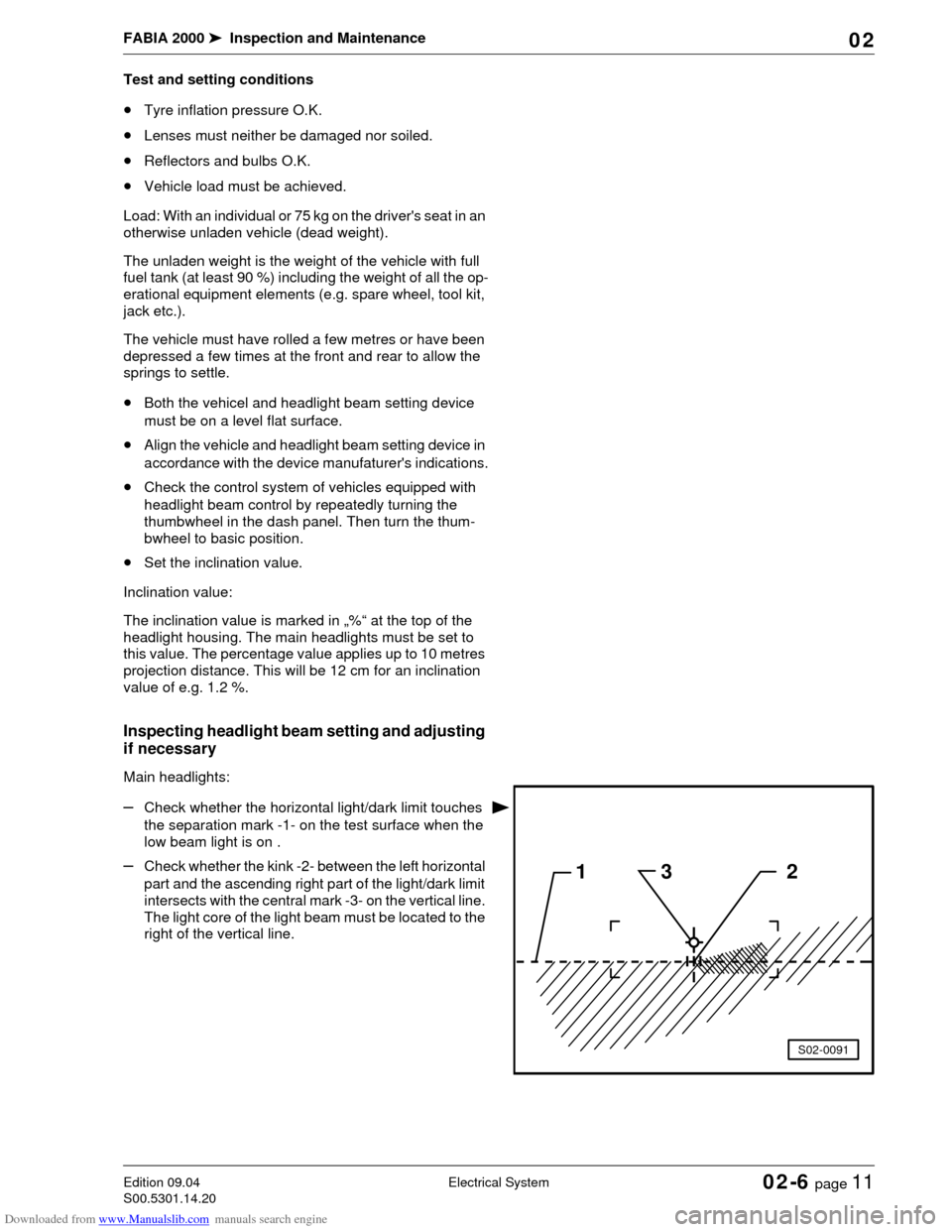
Downloaded from www.Manualslib.com manuals search engine FABIA 2000➤Inspection and Maintenance
Electrical SystemEdition 09.04
S00.5301.14.2002-6 page 11 02
Test and setting conditions
•Tyre inflation pressure O.K.
•Lenses must neither be damaged nor soiled.
•Reflectors and bulbs O.K.
•Vehicle load must be achieved.
Load: With an individual or 75 kg on the driver's seat in an
otherwise unladen vehicle (dead weight).
The unladen weight is the weight of the vehicle with full
fuel tank (at least 90 %) including the weight of all the op-
erational equipment elements (e.g. spare wheel, tool kit,
jack etc.).
The vehicle must have rolled a few metres or have been
depressed a few times at the front and rear to allow the
springs to settle.
•Both the vehicel and headlight beam setting device
must be on a level flat surface.
•Align the vehicle and headlight beam setting device in
accordance with the device manufaturer's indications.
•Check the control system of vehicles equipped with
headlight beam control by repeatedly turning the
thumbwheel in the dash panel. Then turn the thum-
bwheel to basic position.
•Set the inclination value.
Inclination value:
The inclination value is marked in „%“ at the top of the
headlight housing. The main headlights must be set to
this value. The percentage value applies up to 10 metres
projection distance. This will be 12 cm for an inclination
value of e.g. 1.2 %.
Inspecting headlight beam setting and adjusting
if necessary
Main headlights:
–Check whether the horizontal light/dark limit touches
the separation mark -1- on the test surface when the
low beam light is on .
–Check whether the kink -2- between the left horizontal
part and the ascending right part of the light/dark limit
intersects with the central mark -3- on the vertical line.
The light core of the light beam must be located to the
right of the vertical line.132
S02-0091